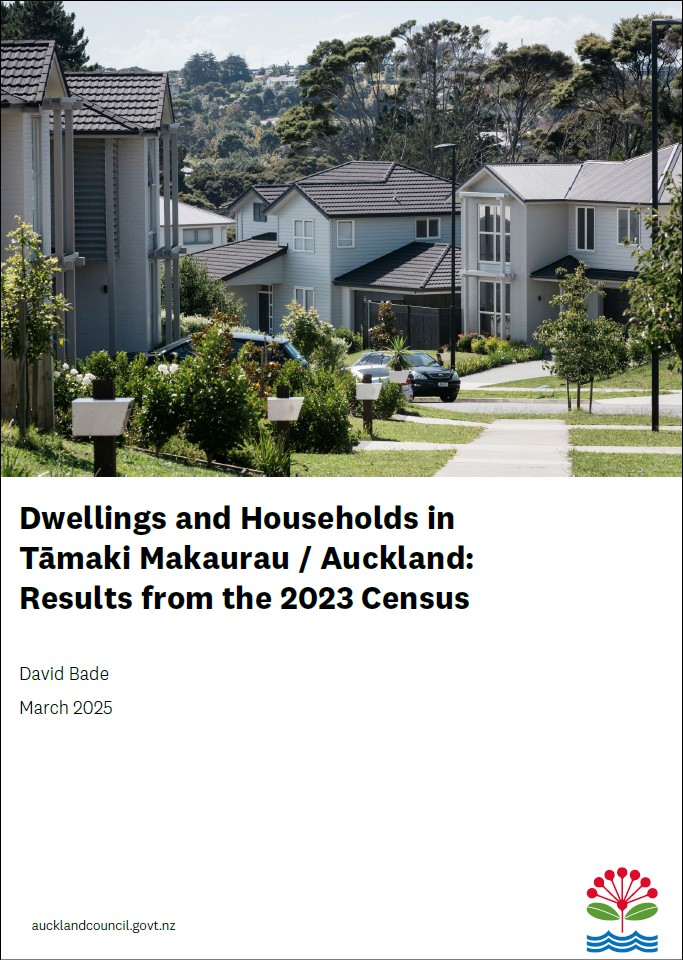Dwellings and households in Tāmaki Makaurau / Auckland: results from the 2023 census
Author:
David BadeSource:
Auckland Council Strategic Advice and Research Unit SARUPublication date:
2025Topics:
People ,HousingExecutive summary
This report presents an overview of dwellings and households in Tāmaki Makaurau/Auckland, based on data from the 2023 Census. It outlines changes over time since the 2018 Census, and, where possible, the 2013 Census. Local board area comparisons are provided, where noteworthy.
The 2023 Census counted 611,895 total dwellings in Auckland, an increase of 64,836 (11.9%) since 2018. This includes 544,083 occupied dwellings, 54,015 unoccupied dwellings (empty or residents away) and 13,979 dwellings under construction. A dwelling may be private (e.g. home residence) or non-private (e.g. hotels and hospitals).
Key findings for Auckland are summarised below:
- 544,083 occupied (private and non-private) dwellings were recorded in 2023, an increase of 70,635 (+14.9%) since 2013. The average annual growth rate between 2018 and 2023 was 1.8 per cent, higher than between 2013 and 2018 (1.1%).
- Although the Auckland isthmus and well-established outer suburbs have the greatest concentration of dwellings, there is a clear pattern of growth in the number of dwellings on the periphery of the urban area.
- Most occupied private dwellings were separate dwellings (71.7%). However, there has been a growing proportion of joined dwellings since 2018 (e.g. apartments, units, townhouses), increasing from 19.2 per cent to 27.9 per cent.
- Over a third (36.8%) of occupied private dwellings were reported to have three bedrooms1, down from 41.0 per cent in 2013. The proportion of dwellings in all other number of bedroom categories has increased in the last two intercensal periods.
- Over half (59.5%) of households in private occupied dwellings owned the dwelling they lived in (with or without a mortgage) or held it in a family trust. This proportion is similar to 2018 (59.4%) but lower than in 2013 (64.5%).
- The proportion of households that owned a private occupied dwelling through a family trust decreased from 15.4 per cent in 2013 to 11.5 per cent in 2023.
- The average length of time occupants of a household had lived in a dwelling they owned (with or without a mortgage) (10 years) or in a public trust (11 years 2 months) was more than double than that for occupants in a dwelling which was not owned (4 years and 7 months). The same difference is seen between 2013, 2018 and 2023.
- Individuals are generally living in dwellings longer, regardless of their ownership, increasing from an average of 7 years 6 months in 2013 to an average of 7 years 11 months in 2023.
- The median weekly rent paid by households in private dwellings was $540 in 2023, up from $350 in 2013 and $450 in 2018.2
- Almost half (47.3%) of households in Auckland were one or two person households (similar to 2013 [48.0%] and 2018 [46.5%]). The largest proportion were two people (28.9%). South Auckland3 local board areas tended to have larger households than northern, central city and island local board areas.
- Using the Canadian National Occupancy Standard, the 2023 Census recorded 45,792 (8.8%) crowded households (i.e. one or two or more bedrooms needed), an increase of 3684 since 2018. The three local board areas with the highest proportion of crowded households were all in south Auckland.
- The proportion of dwellings which are reported to be damp (20.1%) or have mould (over A4 size) (17.4%) has decreased since 2018, but are still highest in the south Auckland local board areas.
- A total of 25,146 households reported not using any form of heating in their dwelling. This equates to 5.0 per cent of all dwellings, and has declined from 8.8 per cent of all dwellings in 2018. The most common form of heating a dwelling was by way of a heat pump (66.3%).
The results of this report are useful for the Auckland Council in planning for future growth and for working with communities to improve quality of life.
_________________________
1The number of bedrooms is reported by the person filling out the dwelling form. A bedroom is defined in the census as a room that is used, or intended to be used, for sleeping in. This includes sleep outs. Caravans next to private dwellings are included if they are used as a bedroom by members of the same household that occupies the dwelling.
2 If converted to March 2023 dollars to account for inflation, these are $445 (2013), $542 (2018) and $540 (2023).
3 When the term ‘south Auckland’ is used in this report, it refers to the local board areas of Māngere-Ōtāhuhu, Ōtara-Papatoetoe, Papakura and Manurewa. This is the area covered by The Southern Initiative which champions, stimulates and enables equitable social and economic development across south Auckland. See: https://www.tsi.nz/.
Auckland Council, March 2025
See also
